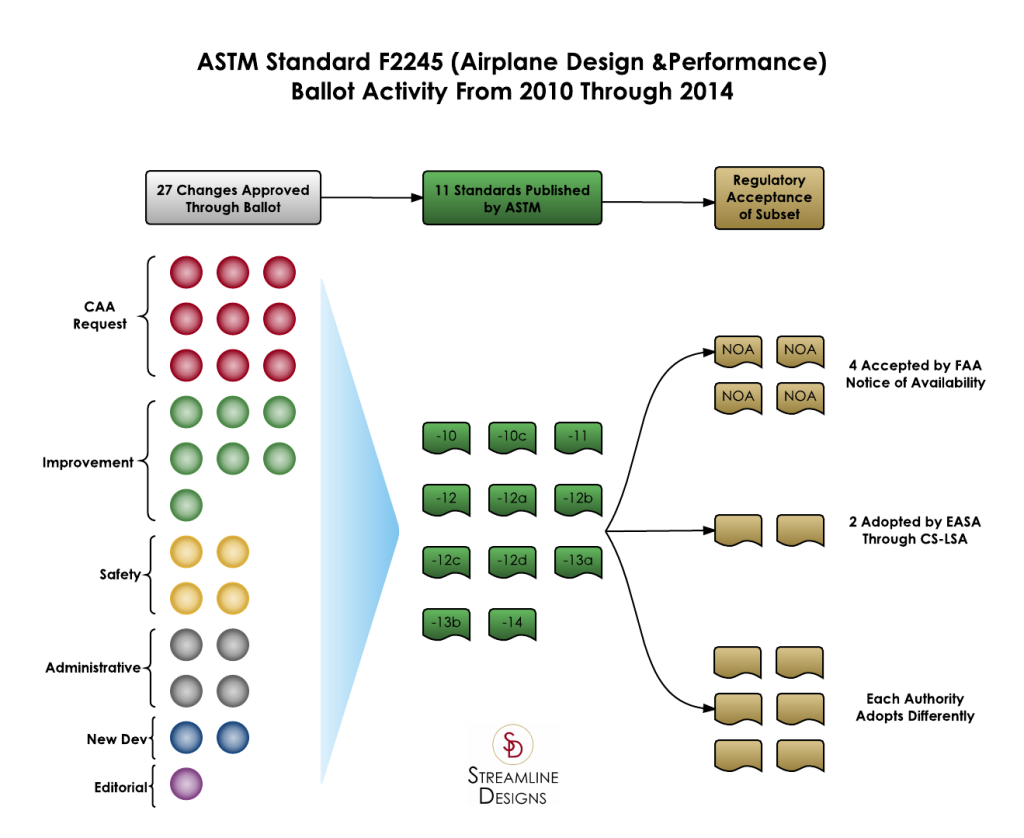Introduction
Over the last several years there has been a great deal of back and forth over F2245 (Standard Specification for Design and Performance of a Light Sport Airplane). The Committee on LSA has always been viewed as a poster child for rapid development and flexibility, being “able to accelerate their standards writing activities and respond efficiently and effectively to marketplace needs.” But the downside of flexibility is the frustration of manufacturers at the mercy of a changing standard, who are sometimes required to make alterations to their aircraft and ultimately, their businesses. We’ve coined the term ‘ballot fatigue’ to capture the sentiment that some manufacturers are expressing regarding the pace of change.
How many changes have there actually been? And of what significance are they? What was the driver for the change initially? Given how frequently these questions are being asked, we set out to help provide some perspective for the answer—at least for the most frequently revised standard, F2245.

As seen in the figure, there is a consolidation process that occurs as ballots are approved, get published by ASTM, and the ultimately get accepted or recognized by Civil Aviation Authorities (CAAs). In the United States, for example, the twenty-seven approved change over the five-year period became real to aircraft manufacturers just four times through the FAA Notice of Availability process—a little less than once per year.
The categories of changes fall into six different categories, each outlined below.
Authority Request (33%)
Nine of these changes were made under the first and most common category, the Authority Request. One-third of the changes made were requested by a CAA. Seven of those ten were a direct result of the Zodiac CH 601 XL investigation. These standards changes included the addition of Operating Maneuvering Speed (VO), calibration of Airspeed Indication System and the elimination of inconsistencies in never-exceed speed (VNE) definition. The other authority requests were made for improving international applicability of the standard (consideration of variable pitch propellers and a new appendix for related requirements when an aircraft is equipped with a variable pitch prop).
Improvement (26%)
There were seven instances when the standards’ existing content was clarified or improved. Some of the items affected by this category of change include minimum useful load, glider towing operational and structural cone angles, and clarification of permanent deformation of structures at limit load. These changes were made to reduce and eliminate confusion.
Safety (15%)
Four safety changes included: IFR/IMC placard or kinds of operation, fuel tank fuel strainers, engine/airframe/propeller vibration interaction, and enhanced safety belt requirements stemming from NTSB fatal accident investigations.
Administrative (15%)
Four of the changes were made to adjust content between standards and/or sections for organizational purposes, often in light of the whole body of standards. When making an administrative change, the committee was diligent to look at all of the standards, not just F2245, when considering content. Sometimes one standard affects, clarifies or confuses another. Administrative changes are made to keep the body of standards running smoothly together. One of those changes involved references to Federal Aviation Regulations (FAR) and European Aviation Safety Agency (EASA) specifications. Two others resulted in harmonizing the information on nose gear loads and firewall thickness.
New Developments (7%)
Periodically new subjects or issues are brought to committee which are deemed appropriate and important enough to be included in the body of standards. When that happens, the change is categorized as a New Development. In the case of F2245 there have been two new developments in the past five years: the integration of electric propulsion and the requirement to use an approved propeller on LSA airplanes.
Editorial (4%)
Editorial changes are made when a correction or clarification of existing content doesn’t affect the meaning or technical aspects of the item at all. The lateral mass ratio equation in the appendices was corrected as an editorial change.
Conclusions
There have been a lot of ballots over a five year period which has created ‘ballot fatigue’. This is certainly unhealthy for the overall industry because people that are tired of reviewing ballots tend to take less care in commenting and voting. The committee leadership is regularly discussing this, putting tools in place, and deliberating carefully in selecting work each year. We have cataloged over one-hundred suggested changes across all of the F37 standards and spend significant time in each committee meeting reviewing the pros and cons of each item. Many items haven’t been pursued due to a lack of positive impact on the industry overall and a recognition of ‘ballot fatigue’. Some other observations follow below:
- There have been between five and six successful ballot topics per year that have translated to a little less than one required change per year for US manufacturers and a total of two changes for European LSA. Other countries like China accept the ASTM-published changes immediately for Type Certificate and Production Certificate applicants. In frameworks like this, close attention to standards changes is important as a manufacturer nears the point of certificate issuance.
- Fatal accidents have driven well over one-third of total balloting activity and about one-third of all accepted ballots. One key strategy for reducing ‘ballot fatigue’ is to design, produce, and support aircraft that are safe through true compliance to the standards.
- Due to the nature of the ASTM process, there is ballot activity related to changes that do not pass through the voting process. In addition, there are subcommittee ballots for each item as it is being developed. This significantly increases the total number of ballots and adds to ‘ballot fatigue’. It also can become difficult to understand why the same ballot items seem to appear multiple times. For those where this causes problems, one strategy is to retract participation at the subcommittee level. This will eliminate almost half of the total ballots while still having an opportunity to review and vote on every item at the main committee level (final vote).
